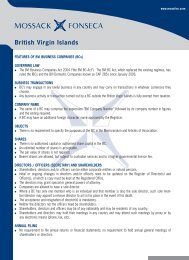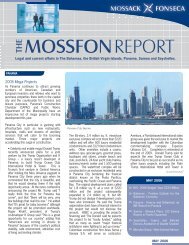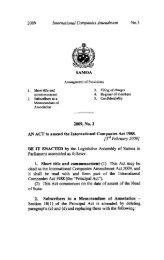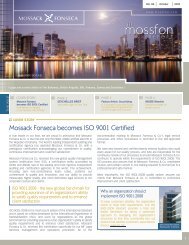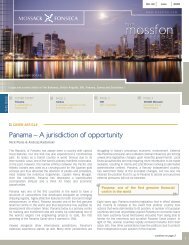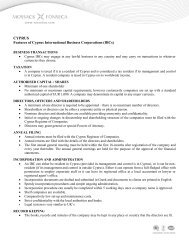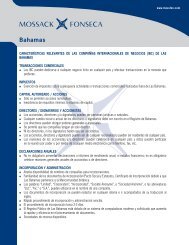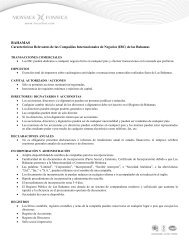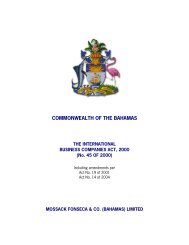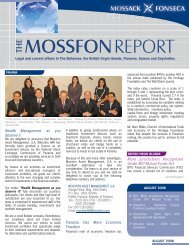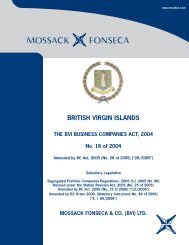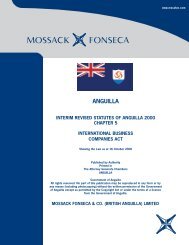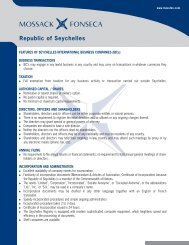Private Foundations.pdf - Mossack Fonseca & Co.
Private Foundations.pdf - Mossack Fonseca & Co.
Private Foundations.pdf - Mossack Fonseca & Co.
You also want an ePaper? Increase the reach of your titles
YUMPU automatically turns print PDFs into web optimized ePapers that Google loves.
3. The Protector<br />
8<br />
The legislation on <strong>Foundations</strong> refers to “supervisory bodies” that are made up of natural persons or<br />
bodies corporate that may be appointed in any way. In most cases, such bodies consist of one sole<br />
person that we call the “Protector.”<br />
In practice, the Protector is usually the client himself or someone he trusts. His functions are<br />
specified in the Foundation Charter. His main functions are the supervision of the Foundation <strong>Co</strong>uncil,<br />
demanding and receiving the Statement of Account, adding or removing beneficiaries and authorizing<br />
the acts of the Foundation <strong>Co</strong>uncil.<br />
The laws on <strong>Private</strong> <strong>Foundations</strong> make no reference whatsoever to the Protector’s liability vis-à-vis<br />
third parties who have an interest in the Foundation.<br />
4. The Beneficiary<br />
The Foundation’s aims and objectives consist, in the last instance, in benefiting the foundation’s<br />
“Beneficiary” or “Beneficiaries.” Such Beneficiaries have the right to receive the earnings or interest<br />
earned by the Foundation Assets, and to receive the Foundation Assets upon fulfillment of the<br />
conditions set down in the Foundation Charter.<br />
The Beneficiaries may be natural persons or bodies corporate and are appointed in the Foundation<br />
Regulations.<br />
The Beneficiaries may sue the Foundation in exercising their legitimate rights concerning the<br />
Foundation Assets, demand the judicial removal of the Foundation <strong>Co</strong>uncil members, demand the<br />
rendering of accounts and object to any acts of the Foundation that impair their rights.<br />
The Beneficiaries shall have rights concerning the Foundation Assets beyond any legal provision on<br />
hereditary matters cited by the Founders’ heirs (save for exceptional cases of lawsuits initiated in<br />
jurisdictions whose inheritance laws are of public order and the Foundation’s Assets are located in<br />
such jurisdictions).<br />
The Beneficiaries are not the Foundation’s owners or creditors, such that they may not claim rights<br />
from it aside from those granted in the Foundation Charter, the Regulations and/or the resolutions of<br />
the Foundation <strong>Co</strong>uncil.<br />
Our Standard Foundation Regulations provide that no certificates or documents on the right to benefit<br />
shall be issued, and such right may not be given in guarantee of any kind. The client may opt to<br />
amend such provision.<br />
In no case may the Foundation Assets be used to answer for the Beneficiaries’ personal obligations.<br />
By the same token, the Beneficiaries shall not be answerable for the Foundation’s obligations.<br />
5. Third Parties<br />
A Foundation’s personal elements are those outlined above. However, in exceptional cases, there<br />
are “third parties” that because of specific acts are involved in a Foundation and acquire rights and<br />
obligations vis-à-vis the Foundation or the Founders.<br />
YA/Pub./10.2007



